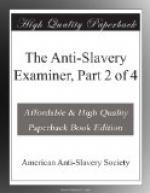slave States, have, in flagrant violation of the letter
and spirit and obvious policy of the Constitution,
enacted in behalf of slavery, that vice would, ere
this, have disappeared from our land. Look, for
instance, at the laws enacted in the fact of the clause:
“The citizens of each State shall be entitled
to all the privileges and immunities of citizens in
the several States”—laws too, which
the States that enacted them, will not consent to
repeal, until they consent to abandon slavery.
It is by these laws, that they shut out the colored
people of the North, the presence of a single individual
of whom so alarms them with the prospect of a servile
insurrection, that they immediately imprison him.
Such was the view of the Federal Constitution taken
by James Wilson one of its framers, that, without,
as I presume, claiming for Congress any direct power
over slavery in the slave States, he declared that
it possessed “power to exterminate slavery from
within our borders.” It was probably under
a like view, that Benjamin Franklin, another of its
framers, and Benjamin Rush, a signer of the Declaration
of Independence, and other men of glorious and blessed
memory, petitioned the first Congress under the Constitution
to “countenance the restoration to liberty of
those unhappy men,” (the slaves of our country).
And in what light that same Congress viewed the Constitution
may be inferred from the fact, that, by a special act,
it ratified the celebrated Ordinance, by the terms
of which slavery was forbidden for ever in the North
West Territory. It is worthy of note, that the
avowed object of the Ordinance harmonizes with that
of the Constitution: and that the Ordinance was
passed the same year that the Constitution was drafted,
is a fact, on which we can strongly rely to justify
a reference to the spirit of the one instrument for
illustrating the spirit of the other. What the
spirit of the Ordinance is, and in what light they
who passed it, regarded “republics, their laws
and constitutions,” may be inferred from the
following declaration in the Ordinance of its grand
object: “For extending the fundamental principles
of civil and religious liberty, which form the basis
wherever these Republics, their laws and constitutions
are erected; to fix and establish those principles
as the basis of all laws, constitutions, and governments,
which forever hereafter shall be formed in the said
territory, &c.; it is hereby ordained and declared
that the following articles, &c.” One of
these articles is that, which has been referred to,
and which declares that “there shall be neither
slavery nor involuntary servitude in the said Territory.”
You will perhaps make light of my reference to James Wilson and Benjamin Franklin, for I recollect you say, that, “When the Constitution was about going into operation, its powers were not well understood by the community at large, and remained to be accurately interpreted and defined.” Nevertheless, I think it wise to repose more confidence in the views, which the framers of the Constitution took of the spirit and principles of that instrument, than in the definitions and interpretations of the pro-slavery generation, which has succeeded them.




